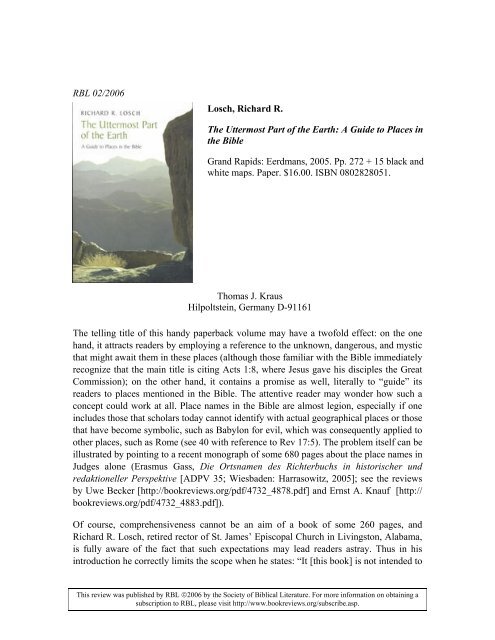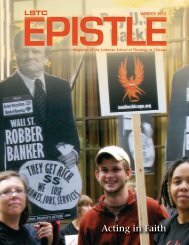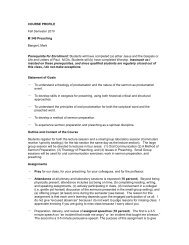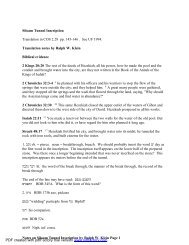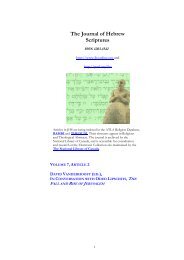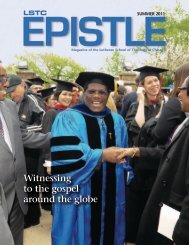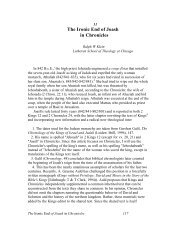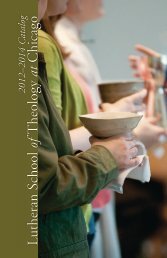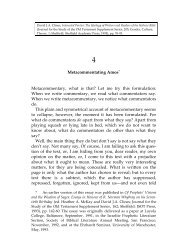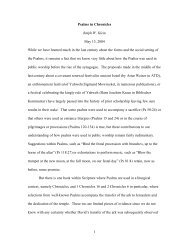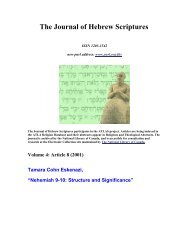Thomas J. Kraus
Thomas J. Kraus
Thomas J. Kraus
- No tags were found...
You also want an ePaper? Increase the reach of your titles
YUMPU automatically turns print PDFs into web optimized ePapers that Google loves.
RBL 02/2006Losch, Richard R.The Uttermost Part of the Earth: A Guide to Places inthe BibleGrand Rapids: Eerdmans, 2005. Pp. 272 + 15 black andwhite maps. Paper. $16.00. ISBN 0802828051.<strong>Thomas</strong> J. <strong>Kraus</strong>Hilpoltstein, Germany D-91161The telling title of this handy paperback volume may have a twofold effect: on the onehand, it attracts readers by employing a reference to the unknown, dangerous, and mysticthat might await them in these places (although those familiar with the Bible immediatelyrecognize that the main title is citing Acts 1:8, where Jesus gave his disciples the GreatCommission); on the other hand, it contains a promise as well, literally to “guide” itsreaders to places mentioned in the Bible. The attentive reader may wonder how such aconcept could work at all. Place names in the Bible are almost legion, especially if oneincludes those that scholars today cannot identify with actual geographical places or thosethat have become symbolic, such as Babylon for evil, which was consequently applied toother places, such as Rome (see 40 with reference to Rev 17:5). The problem itself can beillustrated by pointing to a recent monograph of some 680 pages about the place names inJudges alone (Erasmus Gass, Die Ortsnamen des Richterbuchs in historischer undredaktioneller Perspektive [ADPV 35; Wiesbaden: Harrasowitz, 2005]; see the reviewsby Uwe Becker [http://bookreviews.org/pdf/4732_4878.pdf] and Ernst A. Knauf [http://bookreviews.org/pdf/4732_4883.pdf]).Of course, comprehensiveness cannot be an aim of a book of some 260 pages, andRichard R. Losch, retired rector of St. James’ Episcopal Church in Livingston, Alabama,is fully aware of the fact that such expectations may lead readers astray. Thus in hisintroduction he correctly limits the scope when he states: “It [this book] is not intended toThis review was published by RBL ©2006 by the Society of Biblical Literature. For more information on obtaining asubscription to RBL, please visit http://www.bookreviews.org/subscribe.asp.
e an in-depth study or encyclopedia of biblical sites” (ix). Consequently, places havingplayed “a minor role” are excluded to keep the volume manageable. Additionally, Loschwants to introduce “the stories of the many fascinating places that are mentioned in theBible, as well as some nonbiblical places that played a significant role in Bible times.”That is definitely reasonable and adequately fulfills the purpose of such a book. As far Iam concerned, Losch is successful in making at least one reader “curious” about whatfascinating pieces of information lie behind such extravagant place names such as Ai orBethphage, to mention only two. Furthermore, information becomes even more attractiveif it is presented in such a pleasant narrative style, as is the case here.The inclusion of some nonbiblical places demonstrates that Losch knows of the difficultiesan exclusive concentration on biblical place names might cause. Often knowledge aboutthese nonbiblical places is the key to an in-depth understanding of a certain geographicalname mentioned in the Bible. Such a place name is Sepphoris, which “is never mentionedin the Bible” but “very probably played a major role in the culture of Nazareth and inJesus’ early education.” Of course, such a criterion might cause some trouble, because thecategory of nonbiblical places to be integrated either could increase to such a number thatbecomes unmanageable or the former clear-cut criterion (“which place name is talkedabout why’) becomes “fuzzy” and incomprehensible for a reader. Be that as it may, theintended readership—according to the text on the back cover, “Bible classes, churcheducation,” and those who personally study the Bible—are supplied with a good deal ofinformation that might occasionally surprise the professional scholar as well.The book offers a short introduction (ix–xi); “A Brief History of the Holy Land” (1–11);the presentation of the places, starting with Ai and ending with Ur of the Chaldeans (12–245); six maps (246–51; basically the usual thematic maps: “The Twelve Tribes ofIsrael,” “Ancient Asia Minor,” “The Mediterranean World of the New Testament,”“Palestine in Old Testament Times,” “The Kingdoms and Empires of Old TestamentTimes,” and “Palestine in New Testament Times”); “A Guide to Pronunciation” (252–54); and an cumulative index of names and places (255–60). The book lacks abibliography, although Losch indicates where he has derived his information by citingsome sources in his introduction (x). Here and there black and white photographs visualizethe places or at least some striking parts of them. Of course, the individual entries are ofvaried length according to their significance but also depending on what we know aboutthem (see, e.g., Cana of Galilee on 66 and Rome on 169–201).The informed reader will wonder why an entry on Caesarea Philippi occupies just threepages (to be more precise, only two, if the photographs are omitted [61–63]), which isless than Dan does (83–85). Moreover, some scholars or those interested in Qumran willnot agree with Losch’s depiction of the archaeological site and the place, its history, andThis review was published by RBL ©2006 by the Society of Biblical Literature. For more information on obtaining asubscription to RBL, please visit http://www.bookreviews.org/subscribe.asp.
its purpose (165–68). Further, one would hope for more on the Decapolis than just asingle page of text and a brief footnote (86). Some may even challenge the necessity ofincluding the history of the “Holy Land” in such a volume, if not to speak of its contents(1–11). Additionally, there is a certain focus on the Roman empire (correctly expressedon the back cover) that might be problematic, because such a concentration could lead tothe exclusion of other places.Be that as it may, Losch seeks to present each of the seventy-six places in a neutral andinformative way. He never loses sight of his readers and their needs and thus singles outthe relevant facts and references for them. Of course, scholars may find this and thatsomewhat superficial. However, the audience Losch is writing for will enjoy his vividstyle and the lively depictions so that “[s]ome readers may read this volume cover-tocover,while others may simply dip in to find out more about a particular town or city.”Belonging to the latter type of readers, I am sure I will reach for this book over and overagain, since it is a handy reference resource and a good read.This review was published by RBL ©2006 by the Society of Biblical Literature. For more information on obtaining asubscription to RBL, please visit http://www.bookreviews.org/subscribe.asp.


